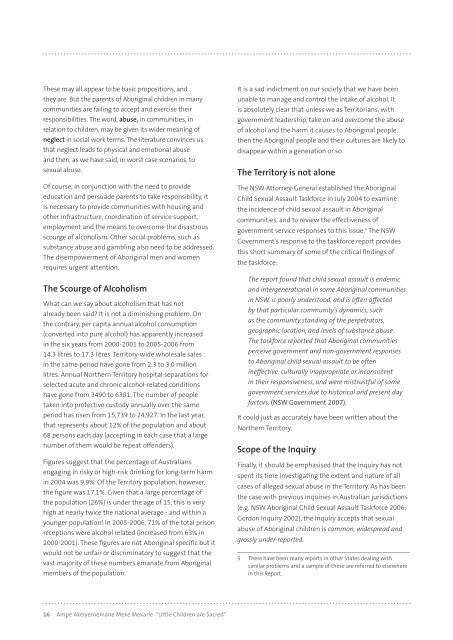bipacsa_final_report
bipacsa_final_report
bipacsa_final_report
Create successful ePaper yourself
Turn your PDF publications into a flip-book with our unique Google optimized e-Paper software.
These may all appear to be basic propositions, and<br />
they are. But the parents of Aboriginal children in many<br />
communities are failing to accept and exercise their<br />
responsibilities. The word, abuse, in communities, in<br />
relation to children, may be given its wider meaning of<br />
neglect in social work terms. The literature convinces us<br />
that neglect leads to physical and emotional abuse<br />
and then, as we have said, in worst case scenarios, to<br />
sexual abuse.<br />
Of course, in conjunction with the need to provide<br />
education and persuade parents to take responsibility, it<br />
is necessary to provide communities with housing and<br />
other infrastructure, coordination of service support,<br />
employment and the means to overcome the disastrous<br />
scourge of alcoholism. Other social problems, such as<br />
substance abuse and gambling also need to be addressed.<br />
The disempowerment of Aboriginal men and women<br />
requires urgent attention.<br />
The Scourge of Alcoholism<br />
What can we say about alcoholism that has not<br />
already been said? It is not a diminishing problem. On<br />
the contrary, per capita annual alcohol consumption<br />
(converted into pure alcohol) has apparently increased<br />
in the six years from 2000-2001 to 2005-2006 from<br />
14.3 litres to 17.3 litres. Territory-wide wholesale sales<br />
in the same period have gone from 2.3 to 3.0 million<br />
litres. Annual Northern Territory hospital separations for<br />
selected acute and chronic alcohol-related conditions<br />
have gone from 3490 to 6301. The number of people<br />
taken into protective custody annually over the same<br />
period has risen from 15,739 to 24,927. In the last year,<br />
that represents about 12% of the population and about<br />
68 persons each day (accepting in each case that a large<br />
number of them would be repeat offenders).<br />
Figures suggest that the percentage of Australians<br />
engaging in risky or high-risk drinking for long-term harm<br />
in 2004 was 9.9%. Of the Territory population, however,<br />
the figure was 17.1%. Given that a large percentage of<br />
the population (26%) is under the age of 15, this is very<br />
high at nearly twice the national average - and within a<br />
younger population! In 2005-2006, 71% of the total prison<br />
receptions were alcohol related (increased from 63% in<br />
2000-2001). These figures are not Aboriginal specific but it<br />
would not be unfair or discriminatory to suggest that the<br />
vast majority of these numbers emanate from Aboriginal<br />
members of the population.<br />
Ampe Akelyernemane Meke Mekarle “Little Children are Sacred”<br />
It is a sad indictment on our society that we have been<br />
unable to manage and control the intake of alcohol. It<br />
is absolutely clear that unless we as Territorians, with<br />
government leadership, take on and overcome the abuse<br />
of alcohol and the harm it causes to Aboriginal people,<br />
then the Aboriginal people and their cultures are likely to<br />
disappear within a generation or so.<br />
The Territory is not alone<br />
The NSW Attorney-General established the Aboriginal<br />
Child Sexual Assault Taskforce in July 2004 to examine<br />
the incidence of child sexual assault in Aboriginal<br />
communities, and to review the effectiveness of<br />
government service responses to this issue. 5 The NSW<br />
Government’s response to the taskforce <strong>report</strong> provides<br />
this short summary of some of the critical findings of<br />
the taskforce:<br />
The <strong>report</strong> found that child sexual assault is endemic<br />
and intergenerational in some Aboriginal communities<br />
in NSW, is poorly understood, and is often affected<br />
by that particular community’s dynamics, such<br />
as the community standing of the perpetrators,<br />
geographic location, and levels of substance abuse.<br />
The taskforce <strong>report</strong>ed that Aboriginal communities<br />
perceive government and non-government responses<br />
to Aboriginal child sexual assault to be often<br />
ineffective, culturally inappropriate or inconsistent<br />
in their responsiveness, and were mistrustful of some<br />
government services due to historical and present day<br />
factors. (NSW Government 2007).<br />
It could just as accurately have been written about the<br />
Northern Territory.<br />
Scope of the Inquiry<br />
Finally, it should be emphasised that the Inquiry has not<br />
spent its time investigating the extent and nature of all<br />
cases of alleged sexual abuse in the Territory. As has been<br />
the case with previous inquiries in Australian jurisdictions<br />
(e.g. NSW Aboriginal Child Sexual Assault Taskforce 2006;<br />
Gordon Inquiry 2002), the Inquiry accepts that sexual<br />
abuse of Aboriginal children is common, widespread and<br />
grossly under-<strong>report</strong>ed.<br />
5 There have been many <strong>report</strong>s in other States dealing with<br />
similar problems and a sample of these are referred to elsewhere<br />
in this Report.


